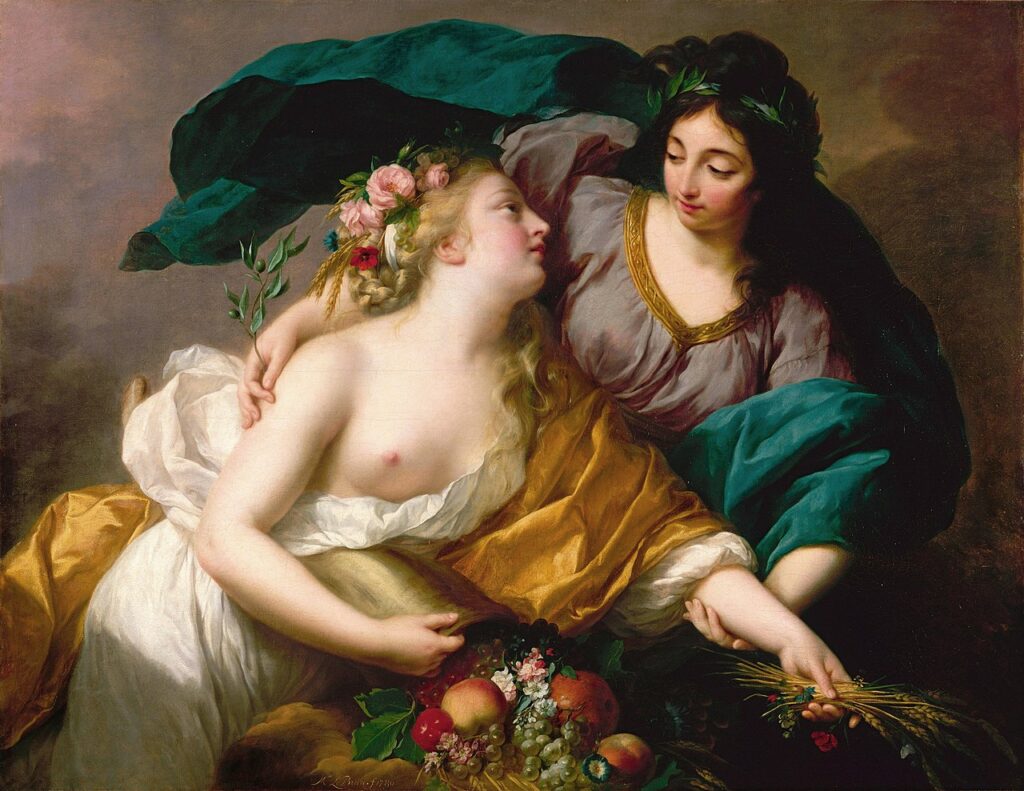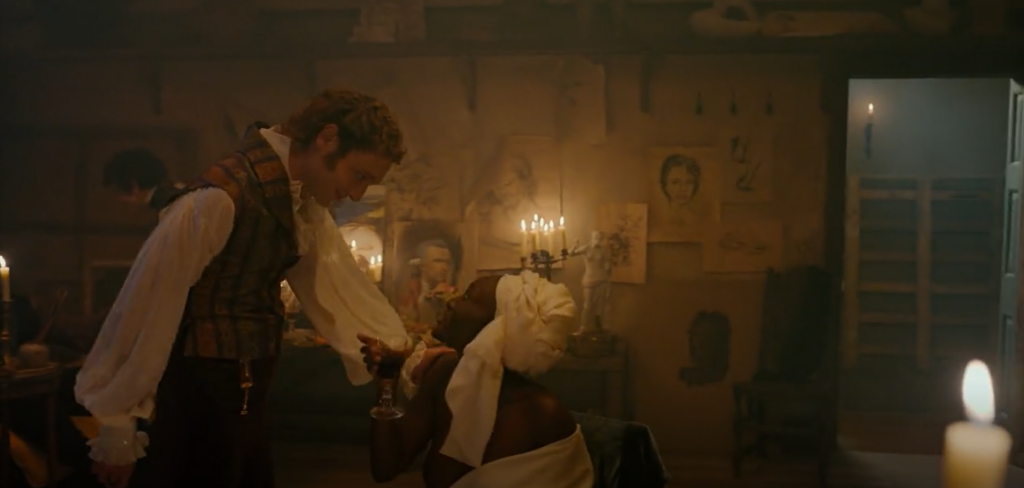Masterpiece Story: Fate of the Animals by Franz Marc
Fate of the Animals is an Expressionist masterpiece by Franz Marc that captures Marc’s admiration of animals and pessimism of...
James W Singer 9 February 2025
16 February 2025 min Read
What is the message behind Marie-Guillemine Benoist’s Portrait of Madeleine? The history and tradition behind this 1800 painting might explain why it has become a source of constant speculation.

Marie-Guillemine Benoist, Portrait of Madeleine, 1800, Louvre, Paris, France.
A young Black woman sits upright in a three-quarter position with her head turned toward the viewer. Her clothes look simple compared to previous eras’ fashions. Her white dress was let loose, revealing her right breast. Her left hand rests on her abdomen to prevent the dress from falling further. We can glimpse the red girdle that gives shape to the dress. Additionally, she wears a white turban to cover her hair, which is balanced out by the golden hoop earring on her right side.
A dark blue drapery covers a Louis XVI-style chair with golden borders and dark green tapestry. The background is a solid greyish surface. The portrait measures 81 cm × 65 cm (32 in. × 26 in.). Benoist’s signature appears above the model’s right hand: “Laville Leroulx, f. Benoist”. She used both her maiden and married names.

Marie-Guillemine Benoist, Portrait of Madeleine, 1800, Louvre, Paris, France. Detail.

Marie-Guillemine Benoist, Self-Portrait, 1786, Staatliche Kunsthalle, Karlsruhe, Germany.
Marie-Guillemine Benoist (1768–1826) was a Parisian neoclassical painter. She studied in the workshops of Elisabeth Vigée le Brun (1755–1842) and Jacques-Louis David (1748–1825), two of the most important painters of the time. Like many women artists, she portrayed herself painting—in this case, copying David’s Belisarius Begging for Alms (1781) to exalt her education. Her talent impressed her peers and patrons. Her works received medals and prizes and led to more commissions. Unfortunately, her career ended with her husband’s promotion during the Bourbon Restoration.

Portrait of a Young Woman in White, c. 1798, National Gallery of Art, Washington, DC, USA.
Benoist was a faithful pupil. Madeleine’s pose, clothes, and even the simple background pay homage to the neoclassical tradition. There is a convention to represent people from a ¾ view of the body, as in portraits such as Portrait of a Young Woman in White made by a follower of David, though they did not always turn to look at the viewer.
Her white dress, imitating the shape of Greek columns, is meant to recall classical antiquity. The ample silhouette of previous fashion trends made way to the elongated, rising waistline just below the breasts. The neoclassical visual simplicity emerged in contrast with the excessiveness and lavishness of the Rococo. And because of that shift in fashion, many portraits went for a simple background, at times composed of one solid color like this one.

Marie-Guillemine Benoist, Portrait of Madeleine, 1800, Louvre, Paris, France. Detail.
Benoist defied traditions as much as she followed them. A Black woman, at that time, was not a common subject for a portrait. In the 18th century, Rococo portraits cast Black people as submissive servants or slaves. They were part of an aristocrat’s possessions, a token of wealth and status. Few neoclassical paintings of dark-skinned people are as relatable as Benoist’s. But Anne-Louis Girodet’s Portrait of Citizen Jean-Baptiste Belley is one of them.

Anne-Louis Girodet de Roussy-Trioson, Portrait of Citizen Jean-Baptiste Belley, 1797, Palace of Versailles, Versailles, France.
Scholars did not always know that Madeleine was Madeleine. For 200 years, this painting was known as Portrait d’une négresse (Portrait of a Black Woman), as it was the name given by Benoist. The models’ identities were not factored in unless they belonged to elite circles. Therefore, many of them remain unknown. However, in 2019, art historian Anne Lafontnew identified the model as a freedwoman named Madeleine from the island of Guadalupe in the Caribbean. She arrived in France in 1794 with Benoist’s brother-in-law. She continued working as a servant in his house, which allowed Benoist to paint her.

Marie-Guillemine Benoist, Portrait of Madeleine, 1800, Louvre, Paris, France. Detail.
Long has been speculated about the meaning of the portrait, even though Benoist did not leave any indication that her work was a political statement. Nevertheless, the date of the portrait, coincidentally six years after Napoleon Bonaparte abolished slavery in the colonies, led scholars to interpret it that way.
Additionally, connections between race and gender were drawn as contemporary feminists fought for emancipation and considered themselves slaves. These were issues that touched Benoist personally, given her social position. Years after painting Portrait of Madeleine, she abandoned her career because it did not suit the role of a middle or upper-class wife. Perhaps she foresaw her fate and empathized with those whose agency was taken away.

Marie-Guillemine Benoist, Portrait of Madeleine, 1800, Louvre, Paris, France. Detail.
Another detail that makes scholars think the portrait is deeper than it seems is the model’s partial nudity. Nudes were not meant to represent real women but allegories, mythologies, and fantastical subjects. As mentioned before, Benoist followed much of the conventions of the time. Therefore, it is not that far-fetched that Madeleine represents more than the freedwoman who modeled for the painting.

Elisabeth Louise Vigée Le Brun, Peace Bringing Back Abundance, 1780, Musée du Louvre, Paris, France.
Just two years before Benoist created Portrait of Madeleine, her teacher Vigée le Brun showed her Peace Bringing Back Abundance. It was an allegory of Peace with her breast bare. The portrait contain mostly neutral colors, with some blue and red highlights. Benoist wrapped Madeleine in the colors of revolutionary France. The blue drapery could be particularly symbolic as it covers the chair that represents the Ancien Régime. Another interpretation is that Benoist alluded to the slave markets where buyers inspected the naked bodies of enslaved people.

Entry from the catalog of the Paris Salon of 1800 showing Marie-Guillemine Benoist’s submission as Portrait d’une négresse. Internet Archive.
Benoist’s art remained outside the Paris Salon for seven years since she started exhibiting her artwork in 1784. Luckily, in 1791, the revolutionary government allowed all artists to submit their work, regardless of their education and gender. Benoist soon built a presence. That year, she became the first female artist to exhibit at the Salon. The jury accepted Portrait of Madeleine in 1800 despite controversy. The painting was placed above eye level. But this still made it accessible to the public.

Antoine Maxime Monsaldy, View of the Works of Painting of Living Artists, Exposed in the Central Museum of Arts on the 8th Year of the French Republic, 1800. Bibliothèque nationale de France.
Benoist’s portrait received mixed reviews. Critics spoke highly of its technique and the ability of the artist to depict Madeleine’s features, but not without racist words.

Art reference to Marie-Guillemine Benoist’s Portrait of Madeleine in Bridgerton, S2E07. Bridgerton/Netflix.
Portrait of Madeleine has seeped into popular culture. The painting appears in Beyonce’s video APESHIT, filmed in the Louvre. Out of the thousands of masterpieces in there, Madeleine had a close-up shot at 5:37. Another reference appeared in Bridgerton. In “Harmony” (So2E07), Anthony Bridgerton visits his brother Benedict at a party at the Royal Academy of Arts. A Black model dressed like Madeleine sits at the center, surrounded by several artists, including a blonde woman who could be Benoist. Neither has a line, but the scene is a subtle reference that offers a fantastical scenario where all races are considered equal in Regency England.

Art reference to Marie-Guillemine Benoist’s Portrait of Madeleine in Bridgerton, S2E07. Bridgerton/Netflix.
The Louvre bought the painting in 1818, and it has remained in their collection ever since. Today, Portrait of Madeleine hangs in Room 935 dedicated to the portraits by Jacques-Louis David and his pupils. It is the only painting with a person of color as a subject.
Whether Portrait of Madeleine conveys a message of emancipation or not, the portrait itself is important in the history of Western art. It was one of the major artworks featured in the 2019 exhibition “Black models: from Géricault to Matisse” at the Musée d’Orsay.”
Alexis Janssen: Deux tableaux, deux mesures : la réception de la race aux Salons du Louvre de 1741 et de 1800, Canvas Journal, 2022. Accessed: Feb. 3, 2025.
Magnolia Molcan: 5 Things to Know about Artist Marie-Guillemine Benoist, Fine Arts Museum of San Francisco, 2023. Accessed: Feb. 3, 2025.
Lyvie Scott: The Famous Painting That Bridgerton Brought To Life, Slash Film, 2023. Accessed: Feb. 3, 2025.
Mathilde Serrell and David Jacubowiez: Le modèle noir, portrait d’une émancipation, 2019, France Culture, 2019. Accessed: Feb. 3, 2025.
James Smalls: Slavery is a Woman: “Race,” Gender, and Visuality in Marie Benoist’s Portrait d’une négresse (1800), Nineteenth-Century Art Worldwide, 2004. Accessed: Feb. 3, 2025.
Paris A. Spies-Gans: Marie-Guillemine Benoist, Revolutionary Painter, ArtHerstory, 2020. Accessed: Feb. 3, 2025.
DailyArt Magazine needs your support. Every contribution, however big or small, is very valuable for our future. Thanks to it, we will be able to sustain and grow the Magazine. Thank you for your help!